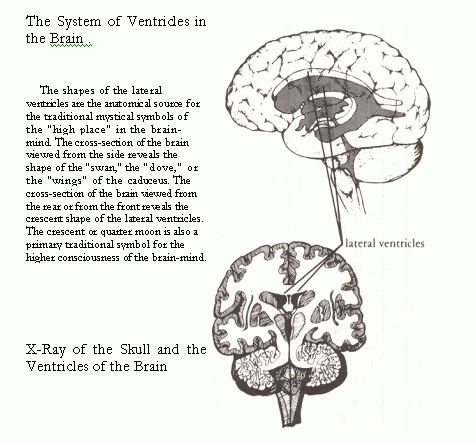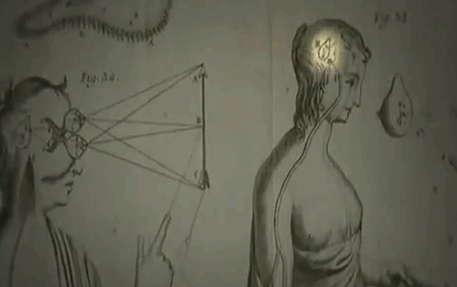
Ajna Chakra (Fifth chakra) is also known as “the third eye”, “the single eye”, or “the mystic eye”, “doorway to the Guru”, this is the subtle psychic center, or chakra, located between and behind the eyebrows and associated with the brain core. The awakening of the ajna chakra may give rise to mystical visions and intuitive reflections of other realms of experience within and outside the individual. The ajna chakra governs the higher mind, will, vision, and conception. It is sometimes also referred to as the “Guru’s Seat”, the psychic center through which the Spiritual Master contacts his or her devotee with his or her Spirit-Blessing.
In The Dawn Horse Testament Of The Ruchira Avatar, chapter twenty-eight, Avatar Adi Da describes the method of meditation at the Ajna Door:
“Truly, The Ajna Door Is Not So Much A Place As It Is A Direction. Therefore, To Feel (and, Thereby, To Contemplate) At The Ajna Door … Is Not Merely To Focus On A Spot In the brain (Between and Behind the brows). Right Feeling-Contemplation At The Ajna Door Is Always A Going Beyond Action, Always Up and Back, Up and Back, Deeper and Deeper, Further and Further. The Upward Motion Goes Beyond The Descending Tendency, and The Backward Motion Goes Beyond The Tendency To Move From The Spinal To The Frontal Line. The Combination Of This Dual Upward (or Ascending) and Backward (or Deepening) Gesture Leads attention Up The Center and, Eventually (In The Possible Context Of The Fifth Stage Of Life), To the top of the head and Beyond, To The Infinite Matrix (or Formless Source) Above.”
In Enlightenment of the Whole Body
The Anatomy of the Third Eye
In the fifth stage of life, the sensorium, or the brain core, wherein the senses and all mind forms originate and are controlled, is inspected and transcended. The traditional descriptions and conceptions of the ascent to the brain core tend not only to be metaphorically religious and cosmological, but they tend also to be related to the primary organ or function of sight. Thus, the mysticism of the fifth stage of life is most often communicated in terms of vision, visions, lights, and the Ultimate Light above all lights. Likewise, the position of contemplation in this stage is most commonly referred to as the “third eye,” or the pineal gland. However, all of this represents a simplistic and exclusive or cultic point of view.
Truly, the higher phase of mystical ascent, or the fifth stage of life, is a matter of concentration of attention in the brain, or the roots of all the sensory and mental functions of the body-mind. Thus, the mechanisms of the brain core, including the cerebellum, the fourth ventricle, the cerebral aqueduct (which is the “narrow gate” of religion and the “brahmarandhra” or “hole of Brahman” of yogis), the brain stem (beginning at the medulla), the corpus quadrigemina, and the diencephalon (including the pituitary body, the hypothalamus, the thalamus, and the pineal body, as well as the third ventricle), are all part of the field of ascended mystical experience in the fifth stage of life.
Certain parts of the brain core are indeed associated with the internal mechanism of vision. Thus, an important aspect of practice in the fifth stage is inspection of the various levels of the phenomena of vision in the brain core. These areas of inspection of internal vision are especially associated with the mechanisms of the optic chiasma, the pineal body, and the visual cortex at the upper rear of the brain.
However, other dimensions of mystical ascent are equally as important as those of vision. Indeed, in the literature of mysticism, the second most prominent mystical phenomenon is that of internal sound or audition. The “Word” is in the same primal position as the “Light.” Thus, another important aspect of practice in the fifth stage is inspection of the various levels of audition in the brain core. The primary areas of inspection of internal audition are in an ascending line, beginning at the medulla (or the “Mouth of God”), and extending into the auditory area of the brain, in the temporal lobe.
Although the internal senses of vision and audition are the primary mystical functions, the mysticism of the fifth stage of life also includes inspection of the internal mechanisms of the senses of taste and smell and touch. Thus, mystical ascent is associated with a total heavenly or supersensual experience, even of a dreamlike or psychedelic variety. But in the Way of Divine Ignorance the significance of practice in the fifth stage of life is not supersensual experience itself or belief in an ascended cosmology wherein the soul journeys to God. Rather, practice in this Way is engaged for the sake of direct inspection of mystical phenomena, re-cognition of them as merely conditions of one’s own body-mind, and thus the transcendence of mysticism itself.
More:
Paradox of Instruction
The subtle path, exemplified by traditions such as shabd yoga (or nada yoga),1 bypasses all involvement with gross or lower energy manipulation, including the kundaliniI, and begins with concentration on the life-current as internal sound and light at the door of the subtle dimension behind the brows (ajna chakra2), thus controlling and absorbing the mind. Since the Goal of such approaches is escape to cognition above the gross level, their methods need not magically improve the karmas below, and so they merely step aside from yogic attention to the gross aspect of the Play. But the traditions of the subtle path, like the kundaliniI and other examples of the gross path, pursue the Goal by entering the subtle realms. The real business of both paths begins at the ajna center (between and behind the brows), evoking the vision of bindu,3 or nil chakra (“blue pearl”), or other versions of the door of manifest light, the epitome of the subtle mind, and awakening a visionary confrontation with the subtle form of the Guru in that same light, who then appears to lead the individual or soul (subtle being) on to the display of subtle energy above the lower-reflecting activity of the mind. This is the adventure of the super-conscious (higher mind) Play in the subtle dimension.
more:
